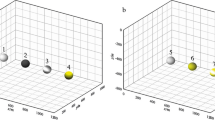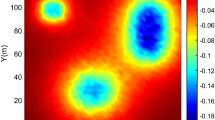Abstract
Microgravity data is used in a mild topography with relatively rough terrain surrounding area to detect, delineate and model the cavities and their probable connections. After standard gravity corrections the Bouguer gravity anomalies are computed. The linear trend of anomalies are detected by using the total horizontal gradient method. This trend of linear anomalies can be caused by connected solution cavities. These cavities are due to the solution of salt deposits (Halite). Using the polynomial fitting approach, the residual gravity anomalies are computed. Several relative negative anomalies are distinguishable in the residual maps and mostly along the assumed linear trends. Rough estimations of the minimum and the maximum depths of these anomalies are provided by Euler de-convolution and upward continuation methods. These anomalies are modeled by the three dimensional inversion algorithms. The computed depths of the main negative anomalies are compared to the depths of the cavities observed in the bore-holes drilling before and during the microgravity survey.











Similar content being viewed by others
References
Ardestani VE (2008) Modeling the karst zones in a dam site through micro-gravity data. Explor Geophys 39:204–209
Arzi AA (1975) Microgravimetry for engineering applications. Geophysics 23:408–425
Blakely JR (1997) Potential theory in gravity & magnetic applications. Cambridge University Press, Cambridge
Butler SJ (1984) Microgravimetric and gravity gradient techniques for detection of subsurface cavities. Geophysics 49:1084–1096
Camacho AG, Fuensanta GM, Viera R (2002) A 3-D gravity inversion tool based on exploration of model possibilities. Comput Geosci 2002(28):191–204
Colley GC (1962) The detection of caves by gravity measurements. Geophys Prospect XI:1–9
Fajklewicz ZJ (1976) Gravity vertical gradient measurements for the detection of small geologic and anthropomorphic forms. Geophysics 41:1016–1030
Jacobson H (1987) A case for upward continuation as a standard separation filter for potential field maps. Geophysics 52:1138–1145
Kane MF (1962) A comprehensive system of terrain corrections using a digital computer. Geophysics 27
Nagy D (1966) The gravitational attraction of a right rectangular prism. Geophysics 31
Thompson DT (1982) EULDPH: a new technique for making computer-assisted depth estimates from magnetic data. Geophysics 47:31–37
Telford WM, Geldart LP, Sheriff RE, Keys DA (1981) Applied geophysics. Cambridge University Press, Cambridge
Waltham T, Bell F, Culshaw M (2005) Sinkholes and subsidence. Praxis, Chichester
Acknowledgements
The author is thankful to the authorities of the Institute of Geophysics, the University of Tehran for all supports and Eng. Salimi for measuring the data.
Special thanks should be given to Mahab-Ghods Consulting Engineering Company for providing geological and bore-holes information and the financial supports.
Author information
Authors and Affiliations
Corresponding author
Rights and permissions
About this article
Cite this article
Ardestani, V.E. Detecting, delineating and modeling the connected solution cavities in a dam site via microgravity data. Acta Geod Geophys 48, 123–138 (2013). https://doi.org/10.1007/s40328-013-0012-x
Received:
Accepted:
Published:
Issue Date:
DOI: https://doi.org/10.1007/s40328-013-0012-x




